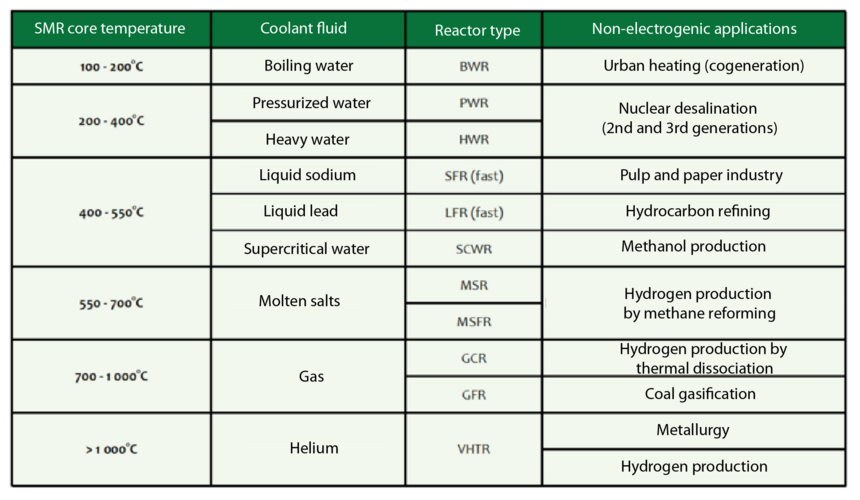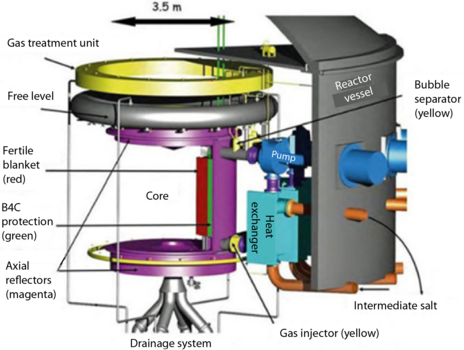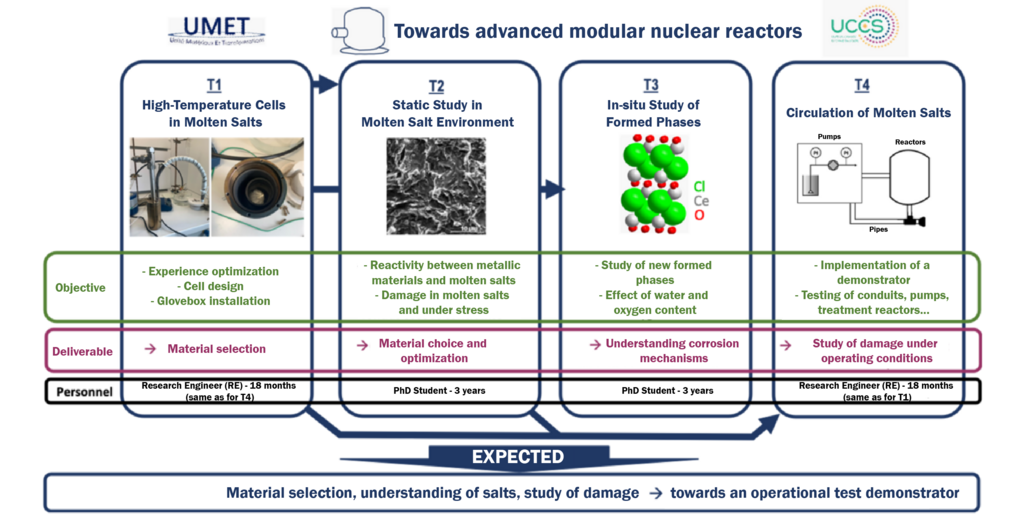PILLAR 4 - HIGH-PERFORMANCE MICRO-ENERGY STORAGE FOR CONNECTED DEVICES
The French government has decided that the development of Small Modular Reactors (SMRs) will be one of the ten priorities of its investment plan until 2030.
SMRs, which stands for Small Modular Reactors, have a power range between 25 and 500 MW, depending on the designs, in comparison to the current civil reactors which typically range from 900 to 1,600 MW. They are called modular because their highly integrated and standardized design allows for serial production and clustered installation, aiming to reduce construction and operation costs. Easily controllable, SMRs are envisioned as a support for electricity production from intermittent sources that require load balancing, such as wind and solar power.
Being located closer to the end users, SMRs enable non-electric applications such as district heating, seawater desalination, hydrogen production, supply of heat for industrial processes, hydrocarbon refining, or naval propulsion for civilian and military purposes. Therefore, by providing both electricity and heat, SMRs can offer a suitable and competitive solution for decarbonized energy production.
Most of the SMR projects worldwide are based on the current third-generation civil nuclear technology, which uses either boiling water or pressurized water reactors operating with thermal neutrons. This is also the case for the Nuward small nuclear reactor project led by EDF. However, some countries, including China, South Korea, Japan, and Canada, are developing fourth-generation SMRs that utilize different coolant fluids (such as liquid metal, molten salts, or high-temperature gas) and/or fast neutrons. These technologies are less mature but better suited for cogeneration or the decarbonization of specific industrial processes.
BWR : boiling water reactor, PWR: pressurized water reactor, HWR: heavy water reactor, SFR: sodium fast reactor, LFR: lead fast reactor, SCWR: supercritical water cooled reactor, MSR: molten salt reactor, MSFR: molten salt fast reactor, GCR: gas-cooled reactor, GFR: gas-cooled fast reactor, VHTR: very high temperature reactor.
The innovative reactors considered in the scope of this study are molten salt reactors (MSRs), which are highly promising systems for the continued utilization of fission energy. These reactors are the focus of one of the Calls for Projects under the PIA4 ISAC program. In this reactor concept, the nuclear fuel is in liquid form, dissolved in molten salt (at temperatures ranging from 550 to 700°C), which serves as both the coolant and the confinement barrier. The reactor can be moderated by graphite (thermal neutrons) or operated without a moderator (fast neutrons). The salt travels through a sealed circuit in a matter of seconds, which includes a vessel where the fuel reaches criticality and heats up, a heat exchanger where the fuel transfers its heat to a coolant fluid, and a pump that ensures the circulation of the salt.
The main section (left) measures 3.5 meters. At the top is the gas treatment unit, followed by a free level, then the core to the right of which there is a side-by-side fertile blanket and B4C protection; the core is located between two axial reflectors, one at the top and one at the bottom, before the drain system. The section on the right consists of the reactor vessel, which runs its full length. Between the reflectors and the tank is a bubble separator, with a pump on its right, followed by a heat exchanger, with a gas injector on its left. The lower part of the tank contains several pipes dedicated to the intermediate salt.
The teams involved in the project aim to collaborate on the issues of material damage caused by molten salts containing a lanthanide that simulates plutonium. The Lille project brings together the expertise of the UCCS teams in lanthanide/actinide chemistry (CIMEND) and molten salts (MISSP), along with the UMET team's expertise in material damage under severe environments (particularly in the presence of liquid metals) (MGPM). The CIMEND team of UCCS has long been involved in issues related to the chemistry of the nuclear fuel cycle, participating in various Research Groups (GdR) such as Matinex, NEEDS, and Scinee, as well as Joint Research Laboratories with industrial partners (LR4CU and PUMA). The MPGM team of UMET has developed experimental skills in material damage in the presence of liquid metal (Pb, Pb-Bi, Na), participating nationally in the GEDEON and GEDEPEON Research Groups and CNRS NEEDS Challenges, and at the European level in various European projects (4th, 5th, 6th, and 7th Framework Programs, Euratom H2020 Project), for about twenty years.
The mentioned teams also participate in the LR4CU and PUMA Joint Laboratories. Furthermore, they jointly responded to the PIA4 call for projects dedicated to innovative solutions for the management of radioactive materials and waste, and the search for alternatives to deep geological disposal through the ISAC (Innovative System for Actinides Conversion) project, which will study the possibility of reducing the inventory of High-Level Long-Lived (HLLL) waste for storage by transmuting minor actinides in a fast spectrum molten salt reactor. In addition, UMET responded to the "HORIZON-EURATOM-2021-NRT-01 - Nuclear Research and Training" call for projects within the INNUMAT (INNovative strUctural MATerials for fission and fusion) project, which includes a component dedicated to materials in the presence of molten salts.
Objectives and scientific challenges
Two technological challenges related to the use of molten salts have been identified:
- Material damage to structural materials due to corrosion phenomena, as well as the coupling of corrosion and mechanical loading.
- The chemistry of salts and its control when in contact with materials.
Thus, one of the scientific objectives of this project is to understand the mechanisms of damage to structural materials of interest in order to eventually guide viable solutions for material selection, including appropriate composition, microstructure, surface condition, etc. The studies will be conducted in molten chloride environments, a technological choice made by the consortium leading the ISAC project (CEA, ORANO, FRAMATOME, EDF, CNRS). To successfully conduct these research activities, the literature emphasizes the importance of salt purity, as the corrosion rate of materials is strongly correlated with the concentration of hydroxide/impurities and O2 in molten chloride salts. Therefore, the chemistry and mastery of salt chemistry represent the second scientific challenge that needs to be addressed in order to successfully carry out this project.
Task description
Task 1 – High-Temperature Cells in Molten Salts
The objective of this task is to design, install, develop, and validate an experiment in chloride-type molten salts that allows for temperature and salt bath chemistry control, as well as conducting tests on selected materials for their use as structural materials (subject of Task 2). A significant portion of this task is dedicated to cell design. To accomplish this, the teams will draw upon their expertise in designing tests in molten salts (UCCS) and tests on liquid metals under controlled atmospheres (UMET). A substantial amount of work will focus on the design and selection of a suitable glovebox, material selection, and the establishment of strict protocols for handling molten salts. Validation of experimental protocols is planned and will also be discussed in collaboration with colleagues from CEA Saclay and LPSC Grenoble.
The presence of a full-time Research Engineer (18 months) on this topic is necessary starting from October 2022.
Task 2 – Static Study in Molten Salt Environment
The objective is to test metallic or ceramic materials of interest for the manufacturing of systems using molten salts. The aim is to study and understand their damage mechanisms in molten salts and under mechanical stress to validate the materials for specific applications or provide improvement directions regarding their microstructure, surface properties, and operating conditions (temperature, loading, salt chemistry). These investigations will rely on parallel static molten salt tests (immersion of specimens under mechanical stress) and post-mortem analysis of damage using various techniques available within the CHEVREUL federation at the University of Lille (XRD, EBSD-EDX-SEM, TEM, ToF-SIMS).
This work will be conducted within the framework of a Ph.D. thesis (2023/2026).
Task 3 – Study of In-Situ Formed Phases
This part of the work deals with the identification and study of phases formed within the salts after conducting tests, depending on the initial impurity content of the salts. Given the reactive environment and working temperatures during damage tests (around 550°C), the formation of new phases such as transition metal and/or lanthanide chlorides/oxichlorides is expected. These phases result from the interaction of salts with fuel and structural materials, and their composition will depend on the water content (and thus oxygen) in the environment. Identifying and understanding the formed phases will contribute to the development of reaction mechanisms and a better understanding of the corrosion mechanisms of the materials of interest. The study will rely on in-depth characterization of solids using structural analysis tools (X-ray diffraction, transmission electron microscopy, electron diffraction) and thermal analyses (TGA, DSC). For characterization purposes, the new phases may be synthesized in pure form.
This work will be conducted within the framework of a Ph.D. thesis (2023/2026).
Task 4 – Molten Salt Looping System
One of the challenges is the establishment of a looping system for molten salts. The envisaged proof of concept will include a small-scale loop that allows for testing various types of conduits, pumps, and treatment reactors in a laboratory setting, using different types of molten salts. This issue encompasses various energy production systems. For example, molten salts are currently being studied for storing excess heat from solar thermal power plants. Such a tool will enable the study of material damage under operating conditions.
The design and realization of this looping system will build upon the results obtained in Tasks 1 and 2 and will require a full-time Research Engineer for 12 months.
The first task is entitled "HT cells in molten salts", its objectives are to optimize the experiment, design the cell and install a glove box, its deliverable is the selection of materials, and the planned staff is a research engineer for 18 months. The second task is a static study in a molten-salt environment, with the aim of investigating the reactivity between metallic materials and molten salts, as well as damage in molten salts and under stress. The deliverable is the selection and optimization of materials; the planned staff is a PhD student for 3 years. The third task is the study of phases formed in-situ, with the aim of studying new phases formed and the effect of water and oxygen content. The deliverable is an understanding of corrosion mechanisms, and the planned staff is a PhD student for 3 years. The fourth and final task is the circulation of molten salts, with the aim of setting up a demonstrator and testing pipes, pumps, treatment reactors, etc., its deliverable is the study of damage under operating conditions, and the planned staff is the same research engineer as for the first task. The four tasks have the common objective of moving towards an operational test demonstrator, through the choice of materials, the understanding of salts and the study of damage.
Impacts
Regardless of the envisioned energy scenario by 2050, the demand for electricity is expected to significantly increase due to the development of electrification in the transportation and industrial sectors, as well as the growing production of hydrogen through electrolysis. Research on Small Modular Reactors (SMRs), which are easily controllable nuclear reactors, contributes to the deployment of an energy mix where the necessary load management is ensured by a decarbonized source rather than fossil fuels such as coal.
Through the study of material damage in molten salt environments, the project actively participates in R&D on SMRs and aligns with the priorities of the French economic recovery plan. It strengthens our collaboration with various nuclear stakeholders in France, particularly with ORANO (a French multinational specializing in nuclear fuel) and FRAMATOME (a French nuclear industry company involved in nuclear power plant design and supplying nuclear boiler equipment and reactor maintenance services) through our joint research laboratories LR4CU (Joint Research Laboratory on Fuel Cycle and Uranium Chemistry) and PUMA. Additionally, collaboration with CEA, which leads a project on the design of molten salt nuclear reactors under the PIA4 (4th Program for Future Investments), and with various CNRS partners involved in the project, further enhances our collaborative efforts.
The establishment of a demonstrator incorporating the circulation of molten salts with a coupled study of salt chemistry and material damage aims to address energy challenges at the Lille site, with the goal of reducing CO2 emissions and waste. This implementation is required for systems involving the circulation of molten salts, such as modular nuclear reactors or solar thermal power plants.
The establishment of such a platform strengthens the collaboration between our two laboratories (UCCS and UMET) and may be open to other teams within the university.
Furthermore, we are currently in discussions with stakeholders regarding the proposal of a "corrosion, oxidation, and high-temperature mechanics" platform within the framework of the IRT M2P (Materials, Metallurgy, and Processes) in Nancy. Our platform could potentially be associated with this project in the future.
This project has the potential to offer opportunities and internships to various programs at the Lille site. This includes the engineering programs in the "Materials Science" field at Polytech'Lille and the programs at ENSCL (École Nationale Supérieure de Chimie de Lille) of Centrale Lille. It also extends to the different tracks within the Chemistry and Physics Masters programs at FST (Faculté des Sciences et Technologies), such as the IPME (Inorganic Materials for Energy and Environment) specialization in the Chemistry Master's program, and the IRACM (Integrated Research for Advanced Chemistry and Materials) Master's program. Furthermore, the experimental development of the demonstrator is expected to contribute to various research projects and lead to several doctoral theses within the SMRE (Sciences des Matériaux et des Ressources en Eau) doctoral school.
References
B. Morel, D. Amaraggi, R. Thomas, M. Rivenet, F. Abraham. Method for converting UO3 and/or U3O8 into hydrated UO4. AREVA NC, WO 2012/084740 A1, 2012.06.28.
M. Arab, B. Morel, M. Rivenet. Method for activating U3O8 with a view to converting same into hydrated UO4. AREVA NC, WO 2015/124682 A1, 2015.08.27.
F. Blanchard, F. Abraham, S. Grandjean, N. Vigier, I. Hablot, M. Rivenet. Process for the synthesis of a mixed peroxide or hydroxo-peroxide of an actinyl and of at least one doubly, triply or quadruply charged metal cation, mixed peroxide or hydroxo-peroxide thus obtained and uses thereof. AREVA NC, WO/2015/091753, 2015.06.25.
A. Belonosov, M. Rivenet, J. Rey, G. Senentz, B. Morel, A. Dumas. Procédé de stockage et de libération d'énergie thermique par voie thermochimique. ORANO, FR 2020/2001847, 2020.02.25. Demande d’extension à l’international en cours.
F. Blanchard, M. Ellart, M. Rivenet, N. Vigier, I. Hablot, B. Morel, S. Grandjean, F. Abraham “Exchange of neodymium for ammonium in uranyl peroxide nanoclusters, towards applications in the nuclear fuel cycle” Chemical Communications 52, 2016, 3947-3950.
R. Thomas, M. Rivenet, E. Berrier, I. de Waele, M. Arab, D. Amaraggi, B. Morel, F. Abraham ‘Thermal decomposition of (UO2)O2(H2O)2·2H2O: Influence on structure, microstructure and hydrofluorination’ Journal of Nuclear Materials 483, 2017, 149-157.
A.L. Vitart, B. Haidon, B. Arab-Chapelet, M Rivenet, I. Bisel, P. Pochon, P. Roussel, S. Grandjean, F. Abraham. From Nd(III) and Pu(III) Oxalates to Oxides: Influence of Nitrilotris(methylenephosphonic acid) on Chemical Composition, Structure, and Morphology. Crystal Growth & Design 17, 2017, 4715-4725.
J.F. Vigier, A. Laplace, C. Renard, M. Miguirditchian, F. Abraham. Uranium (III)-Plutonium (III) co-precipitation in molten chloride. Journal of Nuclear Materials 499, 2018, 394-400.
J.F. Vigier, A. Laplace, C. Renard, M. Miguirditchian, F. Abraham. Uranium (III) precipitation in molten chloride by wet argon sparging. Journal of Nuclear Materials 474, 2016, 2016, 19-27.
F. Housaer, F. Vanni, M. Touzin, f. béclin, J. Allenou, A. Leenaers, A.M. Yacout, H. Palancher, B. Stepnik, O. Tougait, Morphological characterization of the fresh ZrN coated UMo powders used in EMPIrE irradiation experiment: A practical approach, Journal of Nuclear Materials, 2020, 533, 152087.
M. Garrigue, A. Quaini, T. Alpettaz, C. Bonnet, E. Brackx, M. Touzin, O. Tougait, C. Guéneau, Chemical interaction between uranium dioxide, boron carbide and stainless steel at 1900 °C — Application to a severe accident scenario in sodium cooled fast reactors, Journal of Nuclear Materials, 2021, 557, 153266.
I. Proriol Serre, J.-B. Vogt, Liquid metal embrittlement sensitivity of the T91 steel in lead, in bismuth and in lead-bismuth eutectic, Journal of Nuclear Materials, 2020, 531, 152021.
C. Ye, J.-B. Vogt, I. Proriol Serre, Liquid metal embritllement of the T91 steel in lead bismuth eutectic : the role of the loading rate and of the oxygen content in the liquid metal, Materials Science and Engineering A608, 2014, 242–248.
I. Proriol Serre, J.-B. Vogt, N. Nuns, ToF-SIMS investigation of absorption of lead and bismuth in T91 steel deformed in liquid lead bismuth eutectic, Applied Surface Science 471, 2019, 36-42.
Status of current knowledge and developments in France on Molten Salt Reactors, M. Allibert, S. Beils, G. Campioni, B. Carluec, S. Delpech, P. Gauthé, D. Gerardin, A. Gerschenfeld, Y. Gorsse, J. Guidez, D. Heuer, A. Laureau, J. Martinet, E. Merle, J. Serp, Proceedings of the Generation IV International Forum Symposium, Paris, France 2018
Design and Safety Studies of the Molten Salt Fast Reactor Concept in the Frame of the SAMOFAR H2020 Project, E. Merle, M. Allibert, S. Beils, B. Carluec, S. Delpech, D. Gerardin, A. Gerber, D. Heuer, A. Laureau et al. Proceedings of the Generation IV International Forum Symposium, 2018




